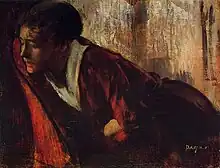| Recurrent brief depression | |
|---|---|
| Other names | Periodic melancholia, intermittent depressive disorder |
 | |
| Melancholy by French artist Edgar Degas (1874) | |
| Specialty | Psychiatry, clinical psychology |
| Symptoms | Low mood, anhedonia, impaired function, suicidal ideation, irritability, anxiety, hypersomnia |
| Complications | Hypomania, self-harm, suicide |
| Duration | 2–13 days for 6–12 times per year |
| Differential diagnosis | Major Depressive Disorder, Dysthymia, Bipolar Disorder, Borderline Personality Disorder |
| Treatment | Psychotherapy, psychopharmacology |
| Frequency | ~9% (lifetime risk); 5% (12-month risk) |
Recurrent brief depression (RBD) defines a mental disorder characterized by intermittent depressive episodes, not related to menstrual cycles in women, occurring between approximately 6–12 times per year, over at least one year or more fulfilling the diagnostic criteria for major depressive episodes (DSM-IV and ICD-10) except for duration in which RBD is less than 14 days (typically 5–7 days).[1] Despite the short duration of the depressive episodes, such episodes are severe, and suicidal ideation and impaired function is rather common. The majority of patients with RBD also report symptoms of anxiety and increased irritability. Hypersomnia is also rather frequent. About 1/2 of patients fulfilling diagnostic criteria for RBD may have additional short episodes of brief hypomania, which is a severity marker of RBD. RBD may be the only mental disorder present, however RBD may also occur as part of a history of recurrent major depressive episodes or bipolar disorders. RBD is also seen among some patients with personality disorders.
Prevalence
Due to the lack of studies for RBD, the results for prevalence vary widely. The lifetime prevalence of RBD has been estimated at 16%, and the one-year prevalence at 5%.[2] The World Health Organization project on "Psychological problems in general health care", which was based on primary care samples, reported a one-year prevalence of 3.7 – 9.9%. However none of these studies differentiate between RBD with and without a history of other mood disorders (e.g. major depression). DSM-IV field trial estimated the lifetime of RBD only to be about 2%.
Cause
The cause of RBD is unknown, but recent findings may suggest a link between RBD and bipolar disorders, pointing to the importance of genetic factors. A small subgroup of patients with RBD have temporal lobe epilepsy.[3]
Treatment
Both psychotherapy as well as different drugs (e.g. serotonin reuptake inhibitors – SSRIs or mood stabilizers, e.g. lithium, antiepileptics) have been suggested as treatments. However, no randomized controlled treatment trial of RBD has been conducted.
History
Disorders characterized by periods with depressive episodes lasting hours to days have been described since 1852 and have been labelled "periodic melancholia", "intermittent depressive disorder" or "brief depression". The third version of the Diagnostic and Statistical Manual of Mental Disorders (1980), which relied heavily on findings from studies conducted in psychiatric in- and out-patient settings, required at least 14 days duration for a diagnosis of depression. No diagnostic category was allocated a depressive episode of shorter duration. Thus, intermittent depressive disorder, included in the Research Diagnostic Criteria (1975) was considered to identify minor versions of major depression ("minor depression") and not included in the DSM-III.
However, based on data from epidemiological studies, the Swiss psychiatrist and researcher, Jules Angst, coined the concept "recurrent brief depression" (RBD) and provided diagnostic criteria for this type of mood disorder in 1985. Several other European studies independently confirmed the occurrence of RBD in the general population and clinical samples. RBD was thus included in the 10th classification of mental and behavioral disorders (ICD-10 F38.1) published by the World Health Organization in 1992 (WHO, 1992; WHO, 1993). Less frequent episodes of brief depressions were labelled "infrequent brief depression" and not included in ICD-10. The American classification system of mental disorders, DSM-IV (1994), provided provisional diagnostic criteria for RBD, but decided to await further studies before including RBD in the classification system. As of 2022, Recurrent Brief Depression is listed under "Other Specified Depressive Disorder" in the DSM-5-TR.
References
- ↑ Montgomery, S. A.; Montgomery, D. (September 1992). "Features of recurrent brief depression". L'Encephale. 18 Spec No 4: 521–523. ISSN 0013-7006. PMID 1308849.
- ↑ Angst, J.; Hochstrasser, B. (April 1994). "Recurrent brief depression: the Zurich Study". The Journal of Clinical Psychiatry. 55 Suppl: 3–9. ISSN 0160-6689. PMID 8077170.
- ↑ "Depression". Epilepsy Foundation. Retrieved 2023-04-02.